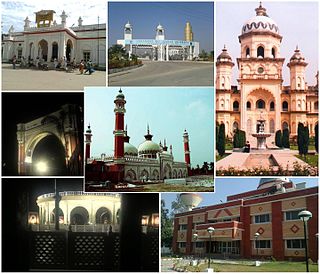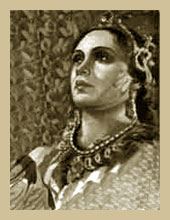Hindi cinema, popularly known as Bollywood and formerly as Bombay cinema, refers to the film industry based in Mumbai, engaged in production of motion pictures in Hindi language. The popular term Bollywood is a portmanteau of "Bombay" and "Hollywood". The industry is a part of the larger Indian cinema, which also includes South Indian cinema and other smaller film industries. The term 'Bollywood', often mistakenly used to refer to Indian cinema as a whole, only refers to Hindi-language films, with Indian cinema being an umbrella term that includes all the film industries in the country, each offering films in diverse languages and styles.

Rampur is a town and the municipality headquarter of Rampur District in the Indian state of Uttar Pradesh. It was formerly known for its various industries, like sugar refining and cotton milling. Its library has more than 12,000 rare manuscripts and a fine collection of Mughal miniature paintings. It is located 322 kilometres north-west of the state capital Lucknow & approx 180 kilometres from the national capital New Delhi.
Nawab is a royal title indicating a ruler, often of a South Asian state, in many ways comparable to the western title of Prince. The relationship of a Nawab to the Emperor of India has been compared to that of the Kings of Saxony to the German Emperor. In earlier times the title was ratified and bestowed by the reigning Mughal emperor to semi-autonomous Muslim rulers of subdivisions or princely states in the Indian subcontinent loyal to the Mughal Empire, for example the Nawabs of Bengal.

Rohillas are a community of Pashtun heritage, historically found in Rohilkhand, a region in the state of Uttar Pradesh, India. It forms the largest Pashtun diaspora community in India, and has given its name to the Rohilkhand region. The Rohilla military chiefs settled in this region of northern India in the 1720s, the first of whom was Ali Mohammed Khan.
The three Round Table Conferences of 1930–1932 were a series of peace conferences, organized by the British Government and Indian political personalities to discuss constitutional reforms in India. These started in November 1930 and ended in December 1932. They were conducted as per the recommendation of Muhammad Ali Jinnah to Viceroy Lord Irwin and Prime Minister Ramsay MacDonald, and by the report submitted by the Simon Commission in May 1930. Demands for Swaraj or self-rule in India had been growing increasingly strong. B. R. Ambedkar, Jinnah, Sir Tej Bahadur Sapru, V. S. Srinivasa Sastri, Sir Muhammad Zafrulla Khan, K. T. Paul and Mirabehn were key participants from India. By the 1930s, many British politicians believed that India needed to move towards dominion status. However, there were significant disagreements between the Indian and the British political parties that the Conferences would not resolve. The key topic was about constitution and India which was mainly discussed in that conference. There were three Round Table Conferences from 1930 to 1932.

Nawab Bahadur Yar Jung was a South Asian politician and foremost Muslim leader in Hyderabad Deccan. He founded All India Majlis-e-Ittehadul Muslimeen and the branches of Khaksars in Hyderabad and was known as a powerful religious preacher. In 1938, he was elected the President of Majlis-e-Ittehadul Muslimeen, a position in which he served till his death.

Nawab Mohammad Iftikhar Ali Khan Pataudi, sometimes I. A. K. Pataudi, was an Indian prince and cricket player.

Fatma Begum (1892–1983) was an Indian actress, director, producer and screenwriter. She was the first female film director of Indian cinema. Within four years, she went on to write, produce and direct many films. She launched her own production house, Fatma Films, which later became Victoria-Fatma Films, and directed her first film, Bulbul-e-Paristan, in 1926.

Bhopal State was founded by Maharaja of Parmar Rajputs. In the beginning of 18th-century, Bhopal State was converted into an Islamic principality, in the invasion of the Afghan Mughal noble Dost Muhammad Khan. It was a tributary state within the Maratha Confederacy during 18th century (1737–1818), a princely salute state with 19-gun salute in a subsidiary alliance with British India from 1818 to 1947, and an independent state from 1947 to 1949. Islamnagar was founded and served as the State's first capital, which was later shifted to the city of Bhopal.
Khan is an ancient Indo-European surname and in the variant of 'Khan' of Mongolic origin, used as a title in various global regions, and today most commonly found in parts of Afghanistan, Pakistan, Iran, Bangladesh, Uzbekistan and India.

Rampur State was a 15 gun-salute princely state of British India. It came into existence on 7 October 1774 as a result of a treaty with Oudh. Following independence in 1947, Rampur State and other princely states of the area, such as Benares and Tehri Garhwal were merged into the United Provinces. Rampur state had its capital in Rampur city and its total area was 945 sq miles. Rampur state was founded by Ali Mohammad Khan's younger son Faizullah Khan.

Nawab Mohammad Mansoor Ali Khan Pataudi was an Indian cricketer and a former captain of the Indian cricket team.
Nazir Hussain was an Indian actor, director and screenwriter. He was famous as a character actor in Hindi cinema and was a pioneer of Bhojpuri cinema. He acted in almost 500 films, with Dev Anand starring in a large proportion of the films he acted in.
The term Khans of Bollywood refers to several actors of Bollywood, the Mumbai-based Hindi language Indian film industry, whose surnames are Khan. Most commonly, this involves the Three Khans: Shah Rukh Khan, Salman Khan and Aamir Khan. The three are unrelated, but happen to share the same surname, and were all born in 1965. Due to their longevity and high popularity, they are considered among the most successful movie stars in the history of Indian cinema.

The Pataudi family is an Indian show business family, primarily working in India's Hindi film industry, commonly known as 'Bollywood'.
Pathans or the Pathans of India are citizens or residents in India who are of ethnic Pashtun ancestry. "Pathan" is the local Hindavi term for an individual who belongs to the Pashtun ethnic group, or descends from it. The Pathans originate from the regions of Eastern Afghanistan and Northwestern Pakistan, ethnolinguistically known as Pashtunistan.









